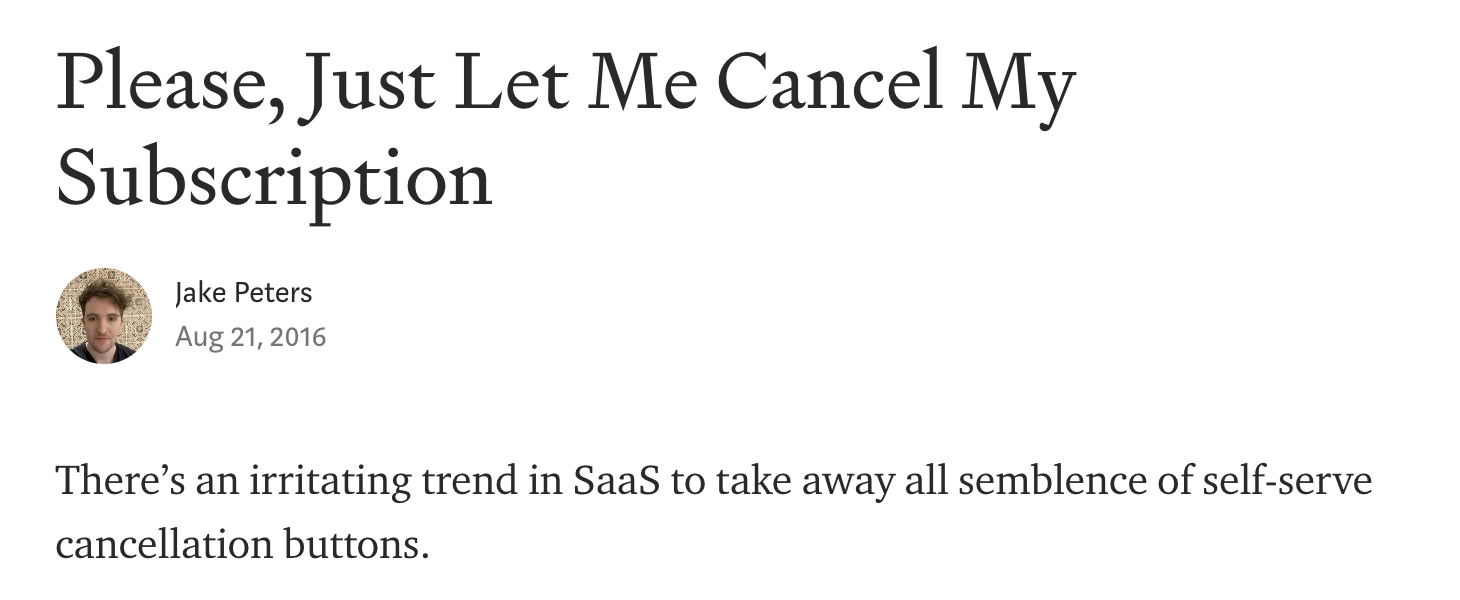6 Reasons You Should Allow Self-Service Cancellation

Consumer and regulatory attention is heating up on difficult cancellation procedures. Are your cancellation hurdles doing more harm than good?
You know customers dread having to make a phone call or jump through other hoops just to cancel a subscription, but as a business owner you may believe these roadblocks help reduce churn.

Perhaps you’d like to offer an online cancellation option but understandably worry it could hurt the bottom line.
I have good news: easy, self-service cancellation flows are great for consumers and business. These are the top six reasons you should allow simple cancellation.
1. You may be legally required to do so
State and federal “click to cancel” laws are increasingly taking aim at difficult cancellation procedures.
Finalized on October 16, 2024, the Federal Trade Commission’s “negative option” rule requires that businesses make canceling a subscription as easy as it is to sign up, and allow cancellation in the “same medium” used to sign up. It applies to businesses across the board, including SaaS, digital media, ecommerce and even in-person transactions like gym memberships.
State-based regulations, like those in California, New York and Florida, mirror the FTC’s. Many states model their statutes after California’s, which is widely considered the strictest in the country.
California’s automatic renewal law requires businesses to provide a “cost-effective, timely and easy-to-use” cancellation mechanism, such as a toll-free phone number, e-mail address or cancellation flow.

Furthermore, for California consumers who signed up online, businesses must provide a “click to cancel” option—without requiring customers to complete a questionnaire or jump through any other hoops.
Even if your business isn’t based in California, the regulations apply for any California consumers you do business with.
In effect, these developments mark the end of call-to-cancel policies for most online subscription-based businesses. If you accept signups online, you must allow customers to cancel online, too.
Fortunately, setting up compliant self-service cancellation doesn’t have to be hard—and can actually reduce churn.
End compliance confusion. Get one-on-one guidance from our cancellation experts. It’s free.
2. Cancellation flows can reduce churn with clear ROI
Contrary to conventional thinking, a self-service cancellation flow can actually reduce churn.
For example, Lincoln Murphy of Sixteen Ventures reports that replacing phone-based cancellation with a self-service cancellation flow produced an immediate reduction in churn.
I’ve seen dramatic results introducing Cancel Flows, including an immediate 15% reduction in churn for an email marketing system where the in-app Cancel Flow replaced the need to call in to cancel.
— Lincoln Murphy, Two Ways to Reduce SaaS Cancellations
Subscription growth expert and founder of 100 Celsius, Bryan Starck recently shared on LinkedIn how subscription cancellation flows can be a key lever in retention and growth:

Or consider a ProsperStack customer. When the Minnesota Star Tribune introduced online cancellation, they worried it might harm customer retention. But with Retain’s powerful A/B testing features, the Star Tribune optimized their cancellation process and obtained an online save rate of 18.5%. That’s 10% higher than their call center.
“ProsperStack is one of the most important and impactful things we’ve implemented in several years,” the paper’s head of retention remarked. See the case study.
How cancellation flows reduce churn
You can think of a cancellation flow as a “churn funnel” that retains customers by reinforcing value and providing persuasive alternatives to cancellation.

Reinforcing value – Reminding customers of your product’s value is a great way to get some to reconsider cancellation. Ask yourself, what benefit has your customer gained by using your product, and how can you effectively highlight that value?
An account summary is a personalized reminder of the value a customer is getting from your product or service. It should contain specific, quantifiable, personal usage metrics such as the number of contacts in a CRM, but you can also include more generic points (e.g. “world-class customer support”).
Another way to reinforce value is through acknowledgements. These are simply statements a customer must accept before completing cancellation. Like an account summary, these statements should highlight what will be lost if the customer cancels, for example, access to a “grandfathered” plan that will no longer be available.

The goal is to bring to consciousness the real value your product has delivered to your customer.
Alternatives to cancellation — This is your final chance to save your customer. Make an effort to address pain points and changing needs. Perhaps escalated support (e.g. a free consult or Calendly link) will be effective. Pausing an account or downgrading to a free plan can maintain the relationship.
Offers (such as a discount, plan upgrade or trial extension) can entice customers to stick around. The secret to making a compelling offer: target incentives based on how customers answer exit survey questions.

For example, you may want to offer a discount to customers who say the product was “too expensive” and a free support upgrade to those that had difficulty using the product. With ProsperStack Retain, you can also target offers based on customer data from your CRM, CDP or other integrations.
Actionable feedback — Let’s not forget the value of user feedback. A cancellation survey can prove a rich source of data for customer churn analysis, roadmap decisions, marketing, sales, budgeting and more, which all add up to improved customer satisfaction and retention. Additionally, survey responses can be used to launch highly-personalized winback campaigns.

3. It makes you better
Making cancellation difficult can provide a false sense of security. When you allow customers to cancel at any time they choose, you know it’s your value proposition and overall product experience that keep them coming back.
This pressure can lead you to excel. It means you’ll need to truly listen to customer feedback and be proactive in addressing concerns. You’ll have to deliver the features and improvements they’re asking for. This also puts pressure on customer support and success to deliver an amazing experience each time they interact with someone.
No doubt having a cancel button at your customers’ fingertips can be scary, but you’ll be better for it.
4. Use it as an effective selling point
Customers don’t like jumping through cancellation hoops. And this distaste can factor into the buying process. Let’s face it, there’s a lot of competition out there. When prospective customers are shopping around, they’re checking out more than price and features. Something as simple as the words “cancel anytime” can be enough to sway them to try your product first.

Put yourself in the buyer’s shoes. If there are several options with similar prices and features, yet one of them boasts a no-contract, cancel anytime offer while the others don’t, which would you try first?
Be that company.
5. A bad cancellation experience can sour customers from returning
There’s a tendency to think of churn as final, but up to 30% of customers who cancel will return at a later date. The fact is, cancellations are often due to external circumstances unrelated to customer satisfaction or product-market fit. In some categories like entertainment, it’s common to have customers come and go.
Final impressions matter. According to the work of psychologist Daniel Kahneman, an individual’s emotional state at the end of an experience colors their perception of the experience as a whole, meaning a bad cancellation process can undermine a customer’s perception of your product, while a great final impression can wash away a lot of negativity.
Instead of forcing customers to jump through hoops to cancel, which only leads to frustration, a simple self-service cancellation flow makes for a positive final experience—meaning customers will be more likely to return to your product again in the future.
6. Manually processing is costly
As your business continues to grow, the administrative cost of having someone follow up with every cancellation and process it manually will add up. You may even need a full-time person to deal with this.
Many cancellations happen near the date of renewal. Without allowing self-service cancellation that takes effect immediately, you’ll find yourself refunding payments to frustrated customers who were charged for an extra term because of your bureaucratic cancellation process.
How ProsperStack can help
Treat your customers the way you want to be treated. Nobody enjoys jumping through hoops to cancel. Instead, provide customers with a top-notch cancellation flow that captures actionable feedback, reiterates the value of your product, provides incentives to stay, and leaves customers with a positive, lasting impression.
Trusted by brands like Nutrafol, Nestle and Hootsuite, ProsperStack Retain is churn-busting cancellation flow software with robust reporting, A/B testing and AI offer optimization. And because we integrate with your subscription billing platform, you can be up and running with just a few lines of code.
Setup is simple:
Connect your subscription platform — Connect Stripe, Chargebee, Recurly, Paddle and more to fully automate subscription cancellation, pauses, trial extensions, coupons and more.
Embed into your site — Seamlessly integrate your new cancellation flow directly into your product with minimal development. Start with our cancellation template based on best practices and customize to your needs by mixing and matching reusable components.
Learn from churn — Collect actionable data from customers who cancel. Make changes at any time with just a few clicks.
Reduce churn with alternatives to cancellation — Automatically present coupons and other incentives to retain customers based on their answers and segments. Optimize with powerful A/B testing, AI Autopilot, customer segmentation and robust reporting.
Analyze and win back — Use the insights you've gathered to improve your product and re-engage churned customers.
Upgrade your cancel button today and start retaining more of your most valuable customers.


